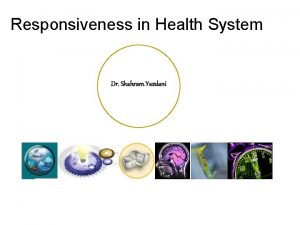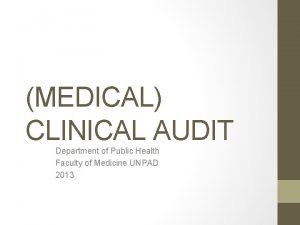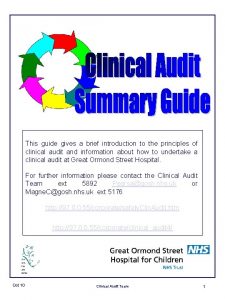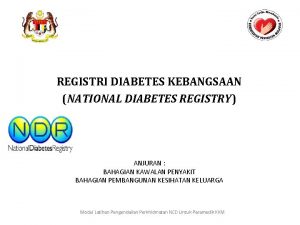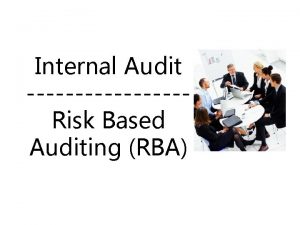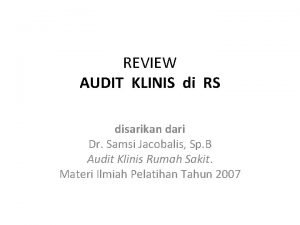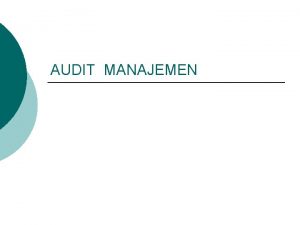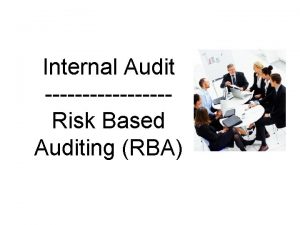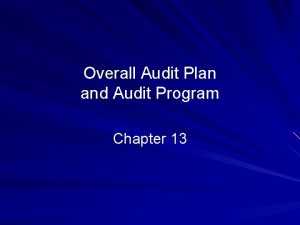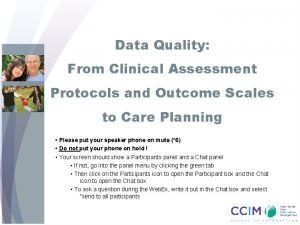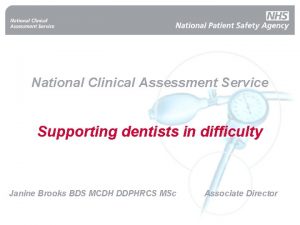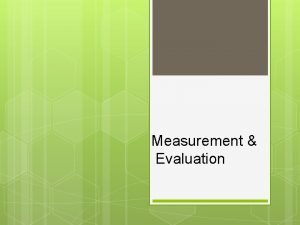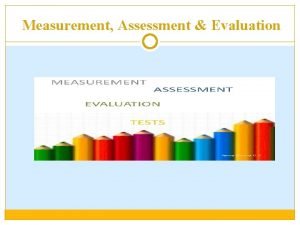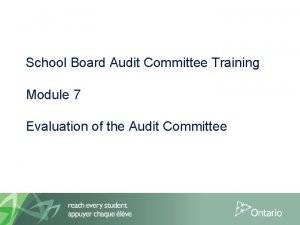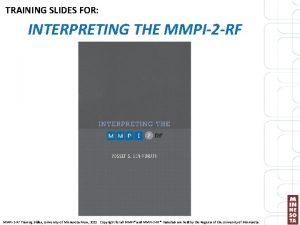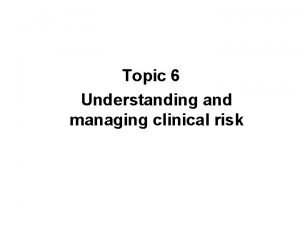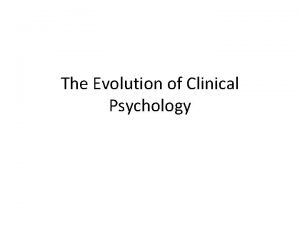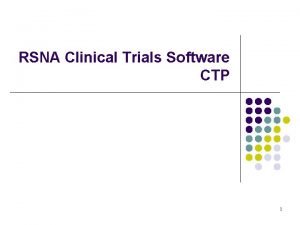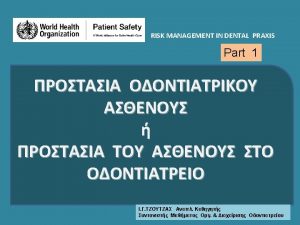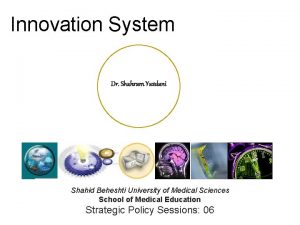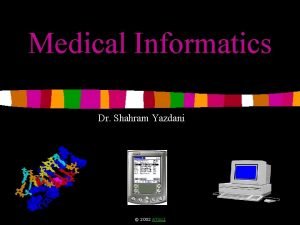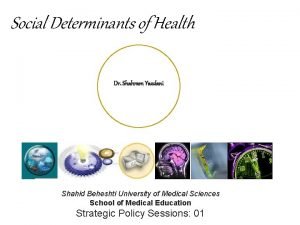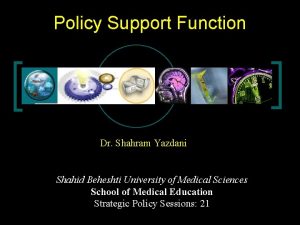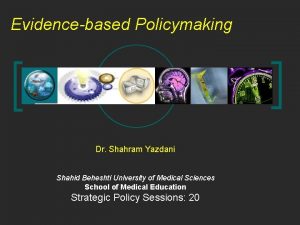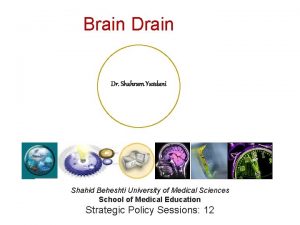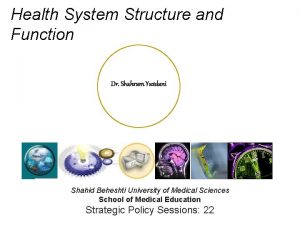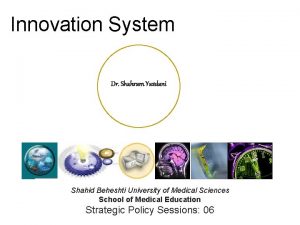Clinical Audit Dr Shahram Yazdani Terminology Measurement Assessment

















































- Slides: 49

Clinical Audit Dr. Shahram Yazdani

Terminology ► Measurement ► Assessment ► Evaluation ► Audit Dr. Shahram Yazdani ► Accreditation





















Using guidelines ► Recommendations Dr. Shahram Yazdani from clinical practice guidelines can be used to develop criteria and standards without substantial additional work. Guidelines now often include suggestions for criteria, a policy that will be followed in guidelines published by NICE. ► As the development of good-quality guidelines depends on careful review of the relevant research evidence, the criteria suggested in such guidelines are likely to be valid.

III – Measuring Performance Dr. Shahram Yazdani

Planning data collection ► To make sure that the data collected are precise, and that only essential data are collected, certain details about what is to be audited must be established from the outset. These are: Dr. Shahram Yazdani § the user group to be included, with any exceptions noted § the healthcare professionals involved in the users’ care § the time period over which the criteria apply.

Planning data collection ► Examples of statements (or ‘inclusion criteria’) that define specific populations for the purposes of particular audits Dr. Shahram Yazdani § All children under 16 years diagnosed with asthma and registered with the primary healthcare team § All people with multiple sclerosis in a hospital § All women receiving treatment for breast cancer in Iran

Collect Only Necessary Data ► It Dr. Shahram Yazdani is always tempting to collect more data than necessary, but only the minimum amount required by the objectives of the audit should be collected. ► It is better to improve a single aspect of care than to collect data on 20 items and change nothing. ► There is an inevitable trade-off between data quality and the costs and practicality of collecting data.

Sampling users ► Once Dr. Shahram Yazdani the group or population of users has been precisely defined by specifying the ‘inclusion criteria’, it is time to decide on the records from which data will be collected. ► It may not always be practical or feasible to include each and every user, and in this case, a representative sample is usually chosen from which inferences about the total population can be made. ► The number needed in the sample is determined by two factors: § The degree of confidence wanted in the findings § Resource constraints (time, access to data, costs).

Handling data: Data sources ► Existing Dr. Shahram Yazdani record and information systems may already be adequate for clinical audit purposes, for example, management information systems may already collect the data required for audit. ► If the required data are not collected routinely, a specific paper or electronic encounter sheet can be devised for healthcare professionals to record needed information during each consultation.

Audit of the management of urinary incontinence: data collection form for an individual user. Dr. Shahram Yazdani

Data abstraction tools ► Data Dr. Shahram Yazdani collection forms must specify precisely the information to be abstracted from the record, and they should be clear and easy to use. ► It is good practice to pilot the data collection form to enable any inherent problems to be detected and corrected. ► It is essential that data collectors undergo training on the use of the data collection form, so any confusing items are identified and a clear policy is established on how data items should be recorded.

Data analysis ► The Dr. Shahram Yazdani type of analysis to be used should be identified at an early stage, as it influence both the type and amount of data collected. ► The analysis can range from a simple calculation of percentages, through to relatively sophisticated statistical techniques. ► On most occasions, however, simple methods are preferable, and indeed, if the results are to stimulate change, the analysis must be simple enough for everyone in the care process to understand.

Concurrent data collection for the administration of thrombolytic therapy (‘door-to-needle time’) Dr. Shahram Yazdani

An example of a bar chart used in a clinical audit Dr. Shahram Yazdani

Example of a statistical control chart used in a clinical audit Dr. Shahram Yazdani

IV – Making Improvements Dr. Shahram Yazdani

Changing Behaviors ► Change can occur at organizational, group, or individual levels. Dr. Shahram Yazdani

Organizational Change ► Organizations can be thought of as existing in a state of quasi-equilibrium, in which driving forces are opposed by restraining forces, with the net effect that changes in the organization are minimized Dr. Shahram Yazdani

Organizational change ► Driving § § § forces Patient pressure National policy Demands from referring general practitioners for improved access ► Restraining forces § Individuals Dr. Shahram Yazdani ► Fear of increased workload ► Concern about staffing and mix ► Loss of control over work patterns § Organizations ► Resistant culture ► Lack of resources ► Rigid structure

Organizational Change ► The Dr. Shahram Yazdani status quo must be ‘unfrozen’ to allow change to occur, followed by ‘refreezing’ to consolidate the new equilibrium. ► In order to create the imbalance between the driving and restraining forces that is needed for unfreezing, the restraining forces should be selectively removed or reduced. ► Merely increasing the driving forces will stimulate an increase in the number or strength of the restraining forces.

Individual change ► The trans-theoretical model, which was developed for management of people with addictive behaviors, such as smoking (Robertson, 1999), explains individual behavior change as a transition through a series of five stages: Dr. Shahram Yazdani § precontemplation – the individual has no intention of changing § contemplation – change is regarded as a possibility in the near future § preparation – explicit plans are made § action – the change occurs § maintenance – the changed behavior is consolidated. ► Progression through each stage is necessary if a change is to occur. No single strategy can encourage someone to progress from precontemplation to maintenance, and different strategies are required at each stage to help a person move on to the next.

Identifying barriers to change ► Interviews Dr. Shahram Yazdani of key staff and/or users ► Discussion at a team meeting ► Observation of patterns of work ► Identification of the care pathway ► Facilitated team meetings with the use of brainstorming or fishbone diagrams

Some methods of identifying barriers to change ► ► Dr. Shahram Yazdani ► The required change is clearly defined, based on evidence, and is presented in a way that staff can easily understand. The barriers to change are identified, including those relating to professionals and to the healthcare organization. Implementation methods are chosen that are appropriate to the particular circumstances, the change itself, and the obstacles to be overcome. An understanding of selected theories of behavior change may be used to inform the choice of methods. An integrated plan is developed for coordinated delivery and monitoring of the interventions. The plan should describe the sequence in which interventions will be made, the staff and resources required to make them, and the target groups. The plan is carried out, and progress is evaluated, with modifications to the plan or additional interventions being used as required.

Promoting successful audit ► In a recent review of 93 studies concerned with a wide variety of clinical audits involving different professional groups, the barriers to successful audit included: Dr. Shahram Yazdani lack of resources lack of expertise in project design and analysis lack of an overall plan for audit poor relationships between professional groups or agencies and within teams § organizational problems, such as lack of a supportive relationship between clinician and managers § §

Promoting successful audit ► Hierarchical Dr. Shahram Yazdani relationships, lack of commitment from senior doctors and managers, poor organizational links between departments, and lack of time and practical support can also be obstacles to those taking part in clinical audit and changing practice

Promoting successful audit ► Factors that promote the success of clinical audit include: sound leadership a conducive/supportive organizational environment structures and systems to support audit, including mechanisms to make data collection easier § a well-managed audit program § addressing a range of issues important to the trust and individual clinicians § giving adequate attention to all stages of audit § § § Dr. Shahram Yazdani

Structural aspects of environment that promote clinical audit ► ► Dr. Shahram Yazdani ► Individuals § § § Time Personal development plans Access to advice about change management Access to a system for reporting concerns Occupational health service available § § § Leadership Clear and shared objectives Effective communication Training in improvement methods Opportunities for the team to meet to share ideas and develop plans Teams Organizations § Explicit commitment to clinical audit within the organization § Clear system for managing a clinical governance program § Staff with responsibility for audit are fully trained and encouraged to develop new solutions to old problems § Good systems for understanding the views of users § Good communication with other health and social care agencies

Cultural aspects of environment that promote clinical audit ► Individuals ► Teams ► Organizations § Positive attitude to audit and improvement § Lack of fear – of change and of confronting less than desired or even poor performance § Open to new ideas § Focus on the user’s experience § Inter-professional respect and cooperation Dr. Shahram Yazdani § Users’ perspectives genuinely regarded as the focus of quality improvement § Open to interest from external agencies in quality of performance, and not afraid of inspection § ‘No blame’ approach to errors § Audit given a high priority

Thank You ! Any Question ? Dr. Shahram Yazdani
 Dr sharam yazdani
Dr sharam yazdani Dr. shahram yazdani
Dr. shahram yazdani Dr shahram yazdani
Dr shahram yazdani Dr. shahram yazdani
Dr. shahram yazdani Dr shahram yazdani
Dr shahram yazdani Challenge word building medical terminology
Challenge word building medical terminology Ncsbn clinical judgment model
Ncsbn clinical judgment model Clinical audit example
Clinical audit example How to do clinical audit a brief guide
How to do clinical audit a brief guide National diabetes registry
National diabetes registry Perbedaan audit konvensional dengan audit berbasis risiko
Perbedaan audit konvensional dengan audit berbasis risiko Perbedaan audit medis dan audit klinis
Perbedaan audit medis dan audit klinis Beda audit medis dan audit klinis
Beda audit medis dan audit klinis Penyelesaian audit dan tanggung jawab pasca audit
Penyelesaian audit dan tanggung jawab pasca audit Hubungan ekonomisasi efisiensi dan efektivitas
Hubungan ekonomisasi efisiensi dan efektivitas Prosedur audit bottom-up dan audit top-down!
Prosedur audit bottom-up dan audit top-down! Difference between interim audit and final audit
Difference between interim audit and final audit Perbedaan audit konvensional dengan audit berbasis risiko
Perbedaan audit konvensional dengan audit berbasis risiko Audit derived from latin word
Audit derived from latin word Audit universe
Audit universe Overall audit plan and audit program
Overall audit plan and audit program Clinical comprehensive assessment
Clinical comprehensive assessment Cas clinical assessment
Cas clinical assessment Abcd assessment nutrition
Abcd assessment nutrition Clinical assessment protocols
Clinical assessment protocols National clinical assessment service
National clinical assessment service Concept map of measurement assessment and evaluation
Concept map of measurement assessment and evaluation Concept map of measurement assessment and evaluation
Concept map of measurement assessment and evaluation Definition of measurement in education
Definition of measurement in education Audit committee self assessment
Audit committee self assessment Risk based internal audit in banks pdf
Risk based internal audit in banks pdf Stages in implementing portfolio assessment
Stages in implementing portfolio assessment Static assessment vs dynamic assessment
Static assessment vs dynamic assessment Portfolio assessment matches assessment to teaching
Portfolio assessment matches assessment to teaching Clinical equipoise
Clinical equipoise Uric acid clinical significance
Uric acid clinical significance University clinical center tuzla
University clinical center tuzla Clinical classification of myopia
Clinical classification of myopia Clinical scales of mmpi
Clinical scales of mmpi Managing clinical risk
Managing clinical risk Fsfd clinical trial
Fsfd clinical trial Nature and scope of clinical psychology
Nature and scope of clinical psychology Clinical value compass
Clinical value compass Good clinical governance adalah
Good clinical governance adalah What is socra
What is socra Clinical significance of albumin
Clinical significance of albumin Charlotte lemech
Charlotte lemech Introduction to clinical laboratory
Introduction to clinical laboratory Rsna ctp anonymizer
Rsna ctp anonymizer Clinical risk management in dentistry
Clinical risk management in dentistry
